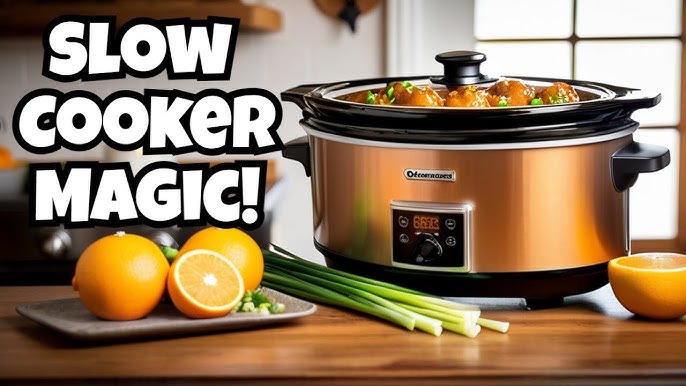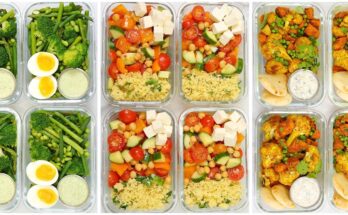Slow Cooking Recipe: Slow cooking isn’t just a method of cooking; it’s a way to bring out deep, rich flavors while saving time in the kitchen. Whether you’re a seasoned cook or a beginner, slow cooking simplifies meal preparation while delivering restaurant-quality results. It’s like having a personal chef at home, gently simmering your food to perfection while you go about your day.
So, why should you consider slow cooking? For starters, it’s economical—you can use affordable cuts of meat and simple ingredients to create mouthwatering meals. Plus, it’s incredibly versatile. Whether you’re craving soups, stews, casseroles, or even desserts, your slow cooker has you covered.
Let’s dive into this step-by-step guide to mastering slow cooking!
Understanding the Basics of Slow Cooking
To get started with slow cooking, it’s essential to understand how it works. A slow cooker, also known as a crockpot, uses low, consistent heat to cook food over several hours. This gradual cooking process allows flavors to meld beautifully while tenderizing even the toughest cuts of meat.
Key Features of a Slow Cooker
- Low and high heat settings
- Removable ceramic pot for easy cleaning
- A glass lid to monitor progress without losing heat
Perfect Dishes for Slow Cooking
- Soups and stews
- Braised meats
- Rice and grain-based dishes
- Even desserts like puddings and cakes!
Choosing the Right Ingredients
The secret to any great recipe lies in the ingredients. For slow cooking, it’s important to select ingredients that hold up well over extended cooking times.
- Meat: Cuts like chuck roast, pork shoulder, and chicken thighs are ideal because they become tender with slow cooking.
- Vegetables: Root vegetables like carrots, potatoes, and parsnips are perfect, as they hold their shape and flavor.
- Herbs & Spices: Slow cooking intensifies flavors, so use dried herbs, bold spices, and seasonings sparingly.
For a burst of freshness, consider adding fresh herbs like parsley or cilantro just before serving.
Preparing Your Ingredients
Preparation is key to a successful slow-cooked dish.
- Vegetables: Chop vegetables uniformly to ensure even cooking. Heartier veggies like carrots and potatoes should be placed at the bottom, closer to the heat source.
- Meat: For richer flavors, brown your meat in a skillet before adding it to the slow cooker. This step isn’t mandatory but adds a deeper, caramelized flavor.
- Layering: Always start with denser ingredients like vegetables, followed by proteins, and finish with liquids like broth or sauces. This ensures even cooking throughout.
Step-by-Step Slow Cooking Process
Step 1: Prepping the Slow Cooker
Spray the inside of your slow cooker with non-stick cooking spray or use a liner to make cleanup a breeze.
Step 2: Browning Ingredients (Optional)
Although not necessary, browning meat and sautéing onions in a pan before adding them to the slow cooker can enhance the flavor of your dish significantly.
Step 3: Adding Liquid and Seasonings
Pour in enough liquid—like broth, water, or wine—to cover the ingredients halfway. Add seasonings, but be cautious as flavors can intensify during slow cooking.
Step 4: Setting Temperature and Timer
Most slow cookers offer low (6-8 hours) and high (3-4 hours) settings. Choose based on your schedule and the dish you’re preparing.
Step 5: Letting it Cook
Once everything is in place, resist the temptation to lift the lid too often! Each time you do, heat escapes, which can add 20-30 minutes to your cooking time.
Slow Cooking Tips for Beginners
- Don’t overfill your slow cooker; leave some room for steam to circulate.
- Avoid adding dairy products like milk or cream early on, as they can curdle. Add them in the final hour of cooking.
- If your dish is too watery, remove the lid during the last 30 minutes to let some liquid evaporate.
Best Recipes to Try for Slow Cooking
If you’re ready to put your slow cooker to the test, here are some delicious recipes to get started:
Classic Beef Stew
- Combine chunks of beef, carrots, potatoes, celery, and onions in your slow cooker. Add beef broth, tomato paste, garlic, and a sprinkle of thyme for flavor. Cook on low for 8 hours or until the beef is tender and the vegetables are perfectly cooked.
Creamy Chicken and Wild Rice
- Place chicken breasts, wild rice, sliced mushrooms, and onions in the slow cooker. Pour in chicken broth and season with garlic, rosemary, and a pinch of salt. After cooking for 6-8 hours, stir in heavy cream or Greek yogurt for a rich, creamy texture.
Vegetarian Chili
- Combine black beans, kidney beans, diced tomatoes, corn, bell peppers, and onions with chili powder, cumin, and paprika. Add vegetable stock, and let it simmer on low for 6 hours. Serve with sour cream and shredded cheese for a hearty, meatless meal.
Making Healthy Slow Cooker Meals
Slow cooking can be incredibly healthy if you make mindful ingredient choices.
- Reduce Fats: Use lean cuts of meat, like skinless chicken breasts or pork tenderloin, to cut down on saturated fats.
- Boost Veggies: Double up on vegetables like spinach, zucchini, or bell peppers to add more nutrients.
- Substitute Wisely: Replace heavy cream with coconut milk, Greek yogurt, or pureed cauliflower for a healthier twist.
- Cut the Salt: Use herbs, garlic, and spices to enhance flavor without relying on excessive salt.
The slow cooker makes it easier to focus on nutritious meals that are filling and flavorful.
How to Add Layers of Flavor
Slow cooking brings out natural flavors, but you can take it up a notch by layering ingredients thoughtfully and using bold seasoning techniques:
- Marinades: Marinating meat overnight before adding it to the slow cooker creates deeper, more complex flavors.
- Broths: Replace water with chicken, beef, or vegetable broth to infuse extra flavor into your dishes.
- Fresh Herbs: Add fresh herbs like cilantro, parsley, or basil at the end to keep flavors vibrant.
- Acid: A splash of vinegar, citrus juice, or wine right before serving can brighten a dish.
Cleaning and Maintaining Your Slow Cooker
Taking care of your slow cooker ensures it stays in top shape for years to come:
- Cleaning Tips: Always let your slow cooker cool before washing. Use warm soapy water and a soft sponge to clean the ceramic insert. Avoid abrasive materials that might damage the surface.
- Removing Odors: If lingering smells remain, fill the slow cooker with water and a splash of vinegar. Heat it on low for an hour, then rinse thoroughly.
- Maintenance: Check the cord and plug periodically for damage, and store the slow cooker in a clean, dry place.
Proper cleaning and maintenance are key to ensuring consistent results with your slow-cooked meals.
Common Slow Cooking Myths Debunked
Let’s tackle some common myths about slow cooking:
Myth 1: Slow cooking is only for soups and stews.
- Truth: You can make a wide variety of meals, including casseroles, roasts, desserts, and even bread in your slow cooker.
Myth 2: Slow cooking takes too much effort.
- Truth: Once the ingredients are prepped, the slow cooker does all the work while you go about your day.
Myth 3: You can’t make desserts in a slow cooker.
Advantages of Batch Cooking with a Slow Cooker
Batch cooking with a slow cooker is a lifesaver for busy weeks.
- Time-Saving: Prepare large quantities of food at once, so you only need to reheat meals during the week.
- Freezer-Friendly: Many slow-cooked dishes, like soups and stews, freeze well for later use. Portion them into containers for easy meal prep.
- Cost-Effective: Cooking in bulk reduces food waste and allows you to buy ingredients in larger, more affordable quantities.
Try batch cooking a hearty chili or shredded chicken, and you’ll thank yourself later when dinner is just a quick reheat away.
Slow Cooking for Special Occasions
Did you know your slow cooker can also be a star at parties and holiday gatherings?
- Impressing Guests: A slow-cooked roast or pulled pork makes a crowd-pleasing centerpiece.
- Holiday Recipes: Prepare mulled wine, warm apple cider, or holiday stuffing with ease in your slow cooker.
- Desserts: Serve slow-cooked apple crisp, bread pudding, or lava cake to end your meal on a sweet note.
With minimal effort, you can wow your guests while enjoying the celebration yourself.
Troubleshooting Slow Cooker Problems
Sometimes, things don’t go as planned. Here’s how to troubleshoot common slow-cooking problems:
- Too Watery: Remove the lid during the last 30 minutes of cooking to let excess liquid evaporate.
- Under-Seasoned: Taste the dish toward the end of cooking and adjust seasonings as needed.
- Overcooked Food: Reduce cooking time or switch to the “keep warm” setting once your dish is done.
By learning these tricks, you’ll handle any slow-cooking mishaps like a pro.
FAQs about Slow Cooking Recipes
What is slow cooking?
Slow cooking is a method of cooking food at a low temperature for an extended period. This process tenderizes tougher cuts of meat and allows flavors to meld beautifully, making it ideal for stews, soups, and casseroles.
Do I need a special pot for slow cooking?
Yes, slow cooking typically requires a slow cooker, also known as a crockpot. These appliances maintain low and steady heat, ensuring your dishes cook evenly without the need for constant supervision.
Can I put raw meat in a slow cooker?
Absolutely! Raw meat can be placed directly in a slow cooker. The prolonged cooking times and low temperatures ensure that meat is cooked thoroughly and safely.
How much liquid should I use?
Unlike other cooking methods, slow cookers require less liquid because there is minimal evaporation. Usually, filling the cooker between one-half to two-thirds is sufficient, but always refer to your specific recipe.
Can I leave my slow cooker on while I’m not home?
One of the major benefits of slow cookers is that they are designed to be left unattended. You can start your cooker in the morning and come back to a ready meal after work, making it perfect for busy schedules.
Is slow cooking healthy?
Slow cooking can be very healthy as it often uses whole food ingredients and requires less oil. Moreover, the low cooking temperatures help in preserving nutrients that are otherwise lost during high-heat cooking.
What are the best recipes for a beginner?
For beginners, hearty recipes like chili, beef stew, or chicken soup are great. These dishes are forgiving and provide a delicious introduction to slow cooking.
Conclusion
Slow cooking is more than just a convenient way to prepare meals; it’s a method that brings out the best in every ingredient. Whether you’re a busy parent, a working professional, or just someone who loves good food, slow cooking has something to offer. With the tips, recipes, and techniques shared here, you’re well on your way to becoming a slow-cooking expert.
So, dust off that slow cooker and give it a try. You’ll be amazed at how effortlessly you can create hearty, flavorful meals that your family will love.



